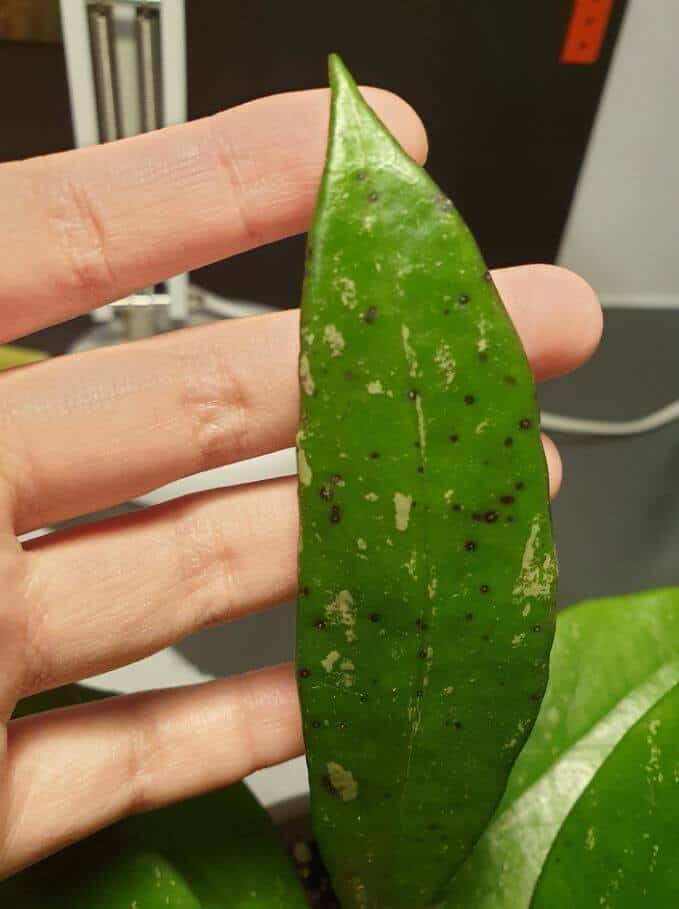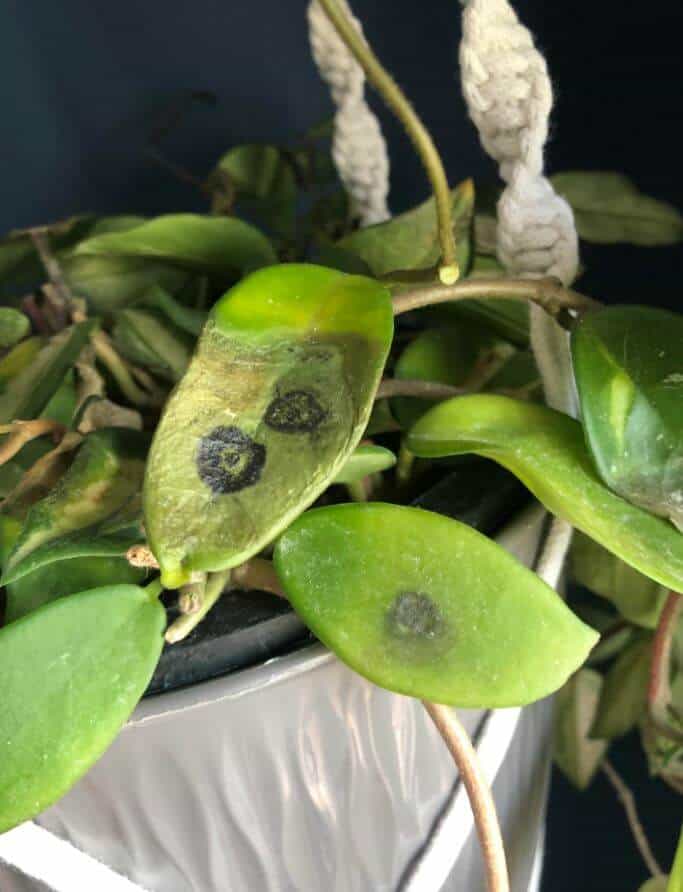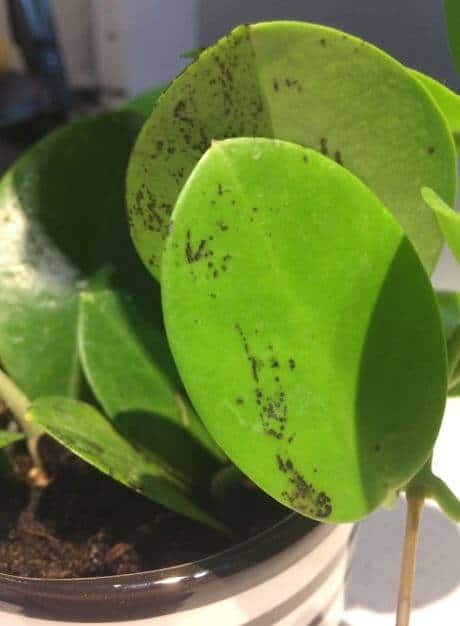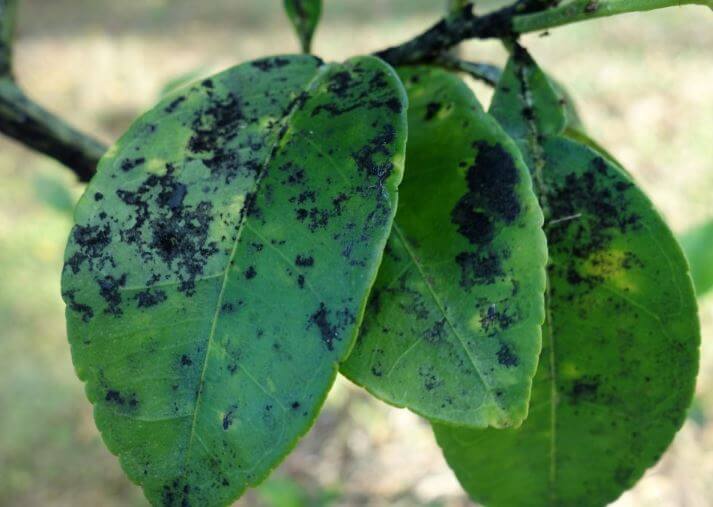Last Updated on August 24, 2023 by a Friendly Gardener
It can be alarming to see black spots appear on the foliage of your favorite hoya plant. Common causes of black spots on hoya leaves include leaf spot infection, pest infestations, overwatering, and excessive moisture. When black spots appear, affected leaves need to be removed from the plant, but you’ll also need to identify the cause to return your hoya plant to health.
What Are the Causes of Black Spots on Hoya Leaves?

Several causes of hoya plant black spots on leaves are due to an improper care routine and can be quickly resolved by adjusting care habits. Here we examine several of the most common reasons that black spots appear and what you need to do to fix the problem.
Overwatering
It’s easy to overwater houseplants especially if you are a beginning gardener. It may happen when you give your plant too much water or your water too often. But it can also be due to other contributing environmental factors such as a container with little or no drainage or a heavy, dense soil mixture with excessive water retention. Both reasons will cause soggy, waterlogged soil without proper aeration meaning that the roots will not receive the oxygen they need to survive. The plant roots will drown.
Symptoms of overwatering can include yellowing and wilting foliage. When left unresolved, this condition can lead to root rot and the death of your hoya plant. Overwatering can also create the perfect environment for fungal infections to develop. These fungi will release their spores into the air, land on foliage, and cause the appearance of black spots.
What to do
Begin by not watering your hoya and permitting the soil bed to dry out completely. Remove yellowing, dying, and dead leaves. If you fear that the root system is compromised, remove the plant from its container to verify the condition of the root system. Infected, black, or mushy roots should be trimmed off. Rinse the healthy roots and treat them with a fungicide such as organic neem oil before replanting your hoya in fresh potting soil. Avoid watering until the soil bed is dry to the touch.
Fungal Infections

Fungal diseases will also cause black spots to appear on hoya leaves. Common fungal infections include:
-
Anthracnose
This is an infection that can attack a variety of houseplants including the hoya. This type of fungus can live in soil mixtures or on the surface of plant stems and leaves. This infection can create a problem if it enters a plant wound or natural opening. Once the infection enters the plant it will produce spores that can spread throughout the plant. Anthracnose can cause dark lesions on hoya foliage and curling, wilting, and leaf drop.
What to do
Remove all infected leaves. Move your plant to a bright location with good air ventilation and water your plant from the bottom to ensure leaves are not wetted. If the infection continues, treat your plant with a fungicide such as neem oil.
-
Black spot fungus

Diplocarponrosae also known as black spot fungus will cause hoya plant black spots on leaves. Spots will gradually become larger and coalesce. Leaves will yellow and eventually fall off. This fungal infection is common when you cultivate a hoya plant in humid or wet conditions.
What to do
Make it a point to water your hoya plant at its base. Avoid wetting foliage. Infected leaves must be pruned off and disposed of. Do not place them in compost to prevent the spread of the disease. Treat your entire plant and the soil with neem oil or a fungicide of your choosing.
-
Fungal leaf spot
This fungal infection will cause black spots on hoya leaves. It generally is the result of excessive moisture on foliage and will spread rapidly if left untreated. Small dark spots are characteristic of this fungal infection. In severe infections, leaves may turn brown and fall off. This infection will severely damage and even kill your hoya plant if you do not intervene.
What to do
Prune off all affected plant parts and dispose of them. Treat your plant with a fungicide. Avoid wetting foliage when watering and reduce somewhat the humidity around the plant if possible.
-
Sooty mold
This is a common fungal infection that covers foliage with a blackish coating. It is commonly found on hoyas that are suffering from scale insects or aphids as they secrete honeydew, a sticky substance that sooty mold feeds on. As the fungus covers leaves, they turn black.
What to do
Pest infestations must be treated with the removal of the insects. Use a cotton pad or swab dampened with rubbing alcohol or treat the plant with an insecticidal horticultural oil such as neem oil. Trim off affected leaves and dispose of them.
Bacterial Infections

Black spots on leaves can also be symptomatic of bacterial infections such as bacterial blight and bacterial leaf spots.
-
Bacterial Blight
Pseudomonas syringaepv. Syringae will attack hoya plants through open wounds. When the infection takes hold, small water-soaked spots will develop and turn black or brown. Often, these spots are surrounded by a yellowish halo. This infection can cause leaf drop.
What to do
Prune off and dispose of infected foliage. Treat your plant with a copper-based fungicide to get the infection under control or try a homemade solution of a quart of water with a tablespoon of baking soda.
-
Bacterial Leaf Spot
Caused by Xanthomonas campestris pv. Vitians, bacterial leaf spots will infect a plant through an open wound. Once the infection takes hold, small black spots develop and will rapidly expand to turn the foliage black or brown. In the case of a severe infection, leaves may wither and die. This bacteria can survive in soil and plant debris for extended periods and can spread through water, wind, or dirty tools.
What to do
Remove infected foliage, place the plant in a spot with good air circulation, and treat your plant with a bactericide.
Viral Infections

Viral infections such as impatiens necrotic spot virus, cucumber mosaic virus, and tobacco mosaic virus can also attack hoya plants. Viruses are often spread by pests like whiteflies or aphids as well as dirty gardening tools. Viral infection symptoms include stunted growth and foliage deformities, yellowing leaves, and black spots on hoya leaves.
What to do
Examine your plants often for pests and treat them promptly. There are no treatments or cures for viral infections. If your plant becomes infected, remove the plant to prevent the spread of the virus.
Pest Infestations
Scales, mealybugs, and aphids like hoya plants can cause black spotting on foliage. These pests are sap suckers and will damage plants causing stunted growth, leaf yellowing, and black spots.
What to do
Wipe pests from the plants with a damp cloth or using a shower head, clean your hoya with a jet stream to remove pests. Treat your hoya with an insecticidal soap or neem oil and repeat until the pests are gone.
In Conclusion
Practicing good hygiene, a proper care routine, and examining your hoya regularly for signs of pests should aid in the prevention of hoya plant black spots on leaves. If they do appear, treat your hoya plant immediately.

